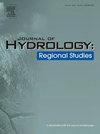Satellite observations of surface water dynamics and channel migration in the Yellow River since the 1980s
IF 4.7
2区 地球科学
Q1 WATER RESOURCES
引用次数: 0
Abstract
Study region
the Yellow River (YR) in China.
Study focus
Due to climate change and human activities, YR channel morphology has undergone significant spatiotemporal variations. Yet, a comprehensive understanding of channel migration in YR and its driving factors remains unclear. Here, we developed a multi-index water extraction method to track the changes in surface water and river channel migration of YR based on Landsat imagery since the 1980s.
New hydrological insights for the region
We find that the average surface water area of YR over the past four decades is 4013 km2, with 73.5 % of permanent surface water. Notably, the surface water extent has experienced a 9 % increase since the 1980s, while the river channel has undergone a 12.2 % decrease. The YR channel’s centerline exhibits diverse change patterns across the entire basin, which can be broadly categorized into six types ranging from unchanged to reverse migration. We identify that climate, particularly temperature and precipitation, contributed 71 % of channel changes in the upper reaches, while 65 % of changes in the lower reaches are from human activities, including reservoir operations and water management policies. Our results unveil the variations in water extent and channel migration of the YR, offering new insights into the interactions between channel migration and climate change and human activities in the YR over the past four decades.
20 世纪 80 年代以来黄河地表水动态和河道迁移的卫星观测结果
研究区域中国黄河。研究重点由于气候变化和人类活动,黄河河道形态发生了显著的时空变化。然而,对黄河河道迁移及其驱动因素的全面了解仍不清楚。在此,我们开发了一种多指标水量提取方法,基于大地遥感卫星图像跟踪自 20 世纪 80 年代以来雅江地表水的变化和河道的迁移。值得注意的是,自 20 世纪 80 年代以来,地表水面积增加了 9%,而河道面积却减少了 12.2%。在整个流域内,YR 河道中心线呈现出多种变化模式,大致可分为六种类型,从不变到反向迁移不等。我们发现,气候,尤其是温度和降水,占上游河道变化的 71%,而下游河道变化的 65% 来自人类活动,包括水库运行和水资源管理政策。我们的研究结果揭示了雅鲁藏布江水域范围和河道迁移的变化,为了解过去 40 年雅鲁藏布江河道迁移与气候变化和人类活动之间的相互作用提供了新的视角。
本文章由计算机程序翻译,如有差异,请以英文原文为准。
求助全文
约1分钟内获得全文
求助全文
来源期刊

Journal of Hydrology-Regional Studies
Earth and Planetary Sciences-Earth and Planetary Sciences (miscellaneous)
CiteScore
6.70
自引率
8.50%
发文量
284
审稿时长
60 days
期刊介绍:
Journal of Hydrology: Regional Studies publishes original research papers enhancing the science of hydrology and aiming at region-specific problems, past and future conditions, analysis, review and solutions. The journal particularly welcomes research papers that deliver new insights into region-specific hydrological processes and responses to changing conditions, as well as contributions that incorporate interdisciplinarity and translational science.
 求助内容:
求助内容: 应助结果提醒方式:
应助结果提醒方式:


